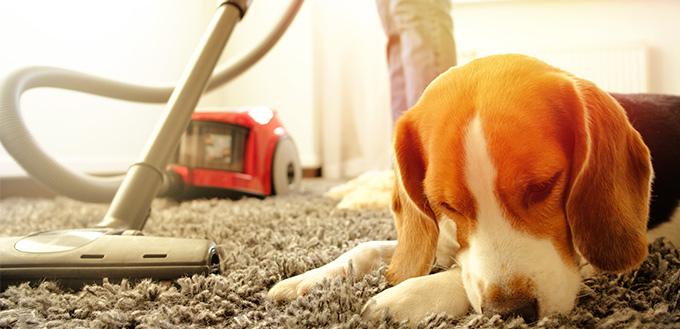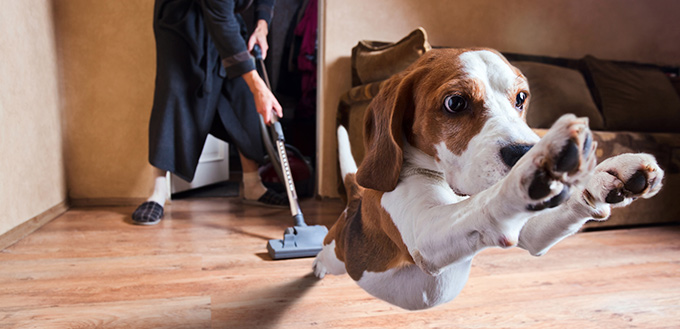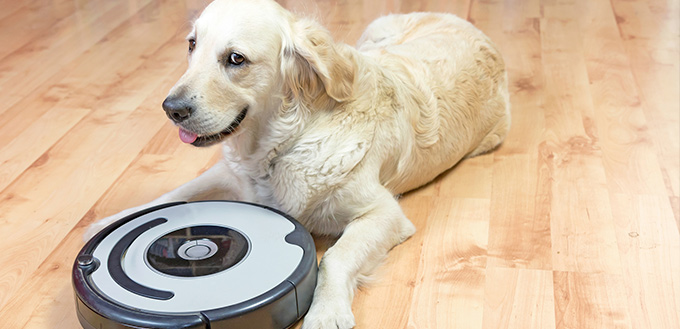Dogs can be scared of a lot of things, from thunder to strangers. One of the most common, yet strange, fears is your vacuum cleaner. Your dog may run and hide, yowl or really freak out when you turn it on. Depending on how severe their reaction, it might be worrying, slightly funny, or downright dangerous. Obviously, you don’t want to live the rest of your life in a dirty home, so what can you do when you want to vacuum?
Related Post: Best Vacuum for Pet Hair

Signs Your Dog is Scared
Not all dogs are frightened by vacuum cleaners, but many are. Bear in mind that it isn’t always immediately obvious when a dog is scared because some signs are clearer than others. While most owners report unmistakable signs, such as barking and running, your dog may also be suffering in silence. When you vacuum, look out for these symptoms of fear and anxiety in your dog:
- Drooling or panting
- Trembling
- Urination
- Dilated pupils
- Cowering
- Licking their lips
- Yawning
- Flattened ears
- Tail tucked away
- Scratching themselves with their paws or against furniture
- Raised hair on the back of the neck
- Not meeting your gaze or avoiding eye contact
- Whining
- Growling
- Barking
- Biting
- Pacing
- Destroying toys or furniture
- Seeking you for comfort, or clinginess
If your dog displays any of these signs while you are trying to vacuum, it is wise that you take action to find a solution. At the very least, regular spells of anxiety and fear are very unpleasant for your dog, but they can also cause further problems. They may be wounded in accidents caused by their behavior or from scratching and biting themselves, and some studies have shown that increased stress and anxiety can shorten your pup’s life span.
Dogs and Vacuum Cleaners
Getting a dog usually means you need to vacuum more than ever, but for many pet owners, it also becomes so much harder to use the vacuum because of your dog’s negative reactions. The first step to finding a solution is to understand what your dog is so afraid of.
By understanding what your dog is afraid of, you are in a better position to know which solution will help your dog the most. After all, if you are trying to solve the wrong problem, you are bound to fail. There are two reasons your dog may be scared of your vacuum.
- The noise
This may seem obvious, but your dog may be scared of your vacuum cleaner because it is very noisy. They may simply get scared by the shock of the sudden noise, and then calm down, or they may remain scared the entire time it is turned on. There are many solutions you can pursue if this is the main cause of your dog’s anxiety.
For example, if your dog is primarily afraid of the noise of the vacuum cleaner, they are probably also afraid of other loud noises, such as thunder and the cars outside. Anxiety and stress can have an adverse effect on their health, so it may be worthwhile to investigate tackling the source of the problem. Training your dog to be less shocked by loud noises will increase their day-to-day comfort levels.
- The sight
Your dog may also be scared of the vacuum because it looks foreign and confusing. Large, unsightly vacuums on wheels can be the worst offenders. They can look like mechanical beasts to your dog, and as they move about the room they can make a dog feel under attack. Self-propelled vacuums, even if they are just little things, can seem like strange, wild animals.
Remember that both aspects could be an issue for your dog. A dog that is scared of the sight and sound of your vacuum will need both aspects to be dealt with. If you only find a solution for their fear of the sight of a vacuum cleaner, they may still be scared by the noise, not to mention other loud noises, and vice versa.

How to Stop Your Dog Being Scared
Unless you are willing to live in piles of hair, tracked in mud, and left over food and kibble, you will want to find a solution for your dog’s fear of vacuums. Depending on how bad their reaction is, the source of the problem, and your circumstances, you may prefer a quick, but superficial, solution, or a long-term solution that addresses the source of the problem.
Change Your Vacuum Habits
A quick, but possibly expensive, fix is to change your vacuuming habits. You could decide to work around your pet by buying a new, quieter and much smaller vacuum that does not frighten them. Unfortunately, it is difficult to tell exactly how your dog will react to this new vacuum, even if it is a lot quieter. You don’t want to discover you have wasted your money.
You could also construct a careful vacuum schedule to suit your dog’s lifestyle. For example, you could work with your partner, flat mates or children to get the vacuuming done while someone takes your dog on their walk. Similarly, if your dog is only afraid of the sight of your vacuum, you can temporarily lock them in one room while you clean the house. This method does not work if it is the sound they are scared of, however, and you may unlock the door to find an unpleasant little accident waiting for you.
Behavior Training
Ultimately, hiding the vacuum from your dog is quite a superficial solution. While you may be able to clean your home again, your dog may still be struggling with an anxious personality that could shorten their lifespan. Tackling the issue head on is best, and this usually means behavior training.
You can work with a professional to train your dog if the problem is severe. This is particularly helpful if your dog seems to have a phobia of all loud sounds. It is likely that a professional dog trainer will use a behavior training method, such as clicker training, to acclimatize your dog to all manner of loud noises through positive reinforcement.
You May Also Like: Dog Training Clickers
To help your dog with their fear of the vacuum, however, it is often possible to manage on your own if you know the basics of dog behavior and conditioning. Training a dog to do anything involves you conditioning them to associate desirable behaviors with positive reinforcement, such as rewards and dog treats. You can do this with your dog and the vacuum using these helpful tips:
- Keep your vacuum out in the open and in a room that is commonly used by your dog. This will acclimatize them to the sight of it. Do not put it in a room where they eat or sleep, however, as this may make them eat or sleep less out of fear.
- Make the vacuum seem as small as possible. This means storing it so it has as little height as possible. This will make it appear as less of a threat to your dog.
- Encourage them to investigate the vacuum while it is switched off. Call them over to it and get them to smell it.
- Condition them to associate the vacuum with positive things, such as their favorite treats, toys, and blanket, by placing these objects on the vacuum. The scent of their favorite things will make them feel more confident approaching the vacuum. You can then use the treat to reward them for approaching and engaging with the vacuum.
- Once you have had a number of successful sessions with the vacuum cleaner turned off, you can try turning on the vacuum. The noise will make them run, but, ideally, your dog will now not be fearful enough to do more than run away and then observe from a distance.
- Keep the vacuum on for a while without moving it and gently encourage your dog to come investigate. They may not work up the courage straight away, but, as before, you can use positive incentives and rewards. It may take a few attempts, so be sure to reward any small victories, such as taking just a few steps towards the vacuum.
- Once your dog has investigate the switched on vacuum and seems more comfortable, you can use the next session to make your first attempt to actually clean something. When you start vacuuming, keep the vacuum away from your dog, and, where possible do not push the vacuum directly at them. As before, your aim is to encourage a safe environment for healthy curiosity in your dog.
- Try to talk to your pet as you use your vacuum. Use a calm, low tone. Your dog finds your voice and presence reassuring, and by chatting in a calm manner, you are telling them that they are safe. You may also try to gently call them over to encourage their curiosity.
- Remember to reward them when they get through a vacuuming session. Offer them a treat after you have turned off the vacuum to further associate the act of vacuuming with other enjoyable experiences.
Behavior training can take a long time, and you may need to use the vacuum in that period of time. If this is the case, it can be beneficial to utilize both the methods we’ve outlined in this article. You can adjust your vacuuming habits and schedule temporarily, just to give you the time to properly train your dog to accept the vacuum as safe.
Related Post: Best Dog Toys

If all goes well, you may even one day be able to try out doggie vacuum grooming. You can buy special dog grooming attachments for vacuums that you can use to regularly groom your dog. This may even cut down on the amount of vacuuming you have to do around the house!
Sources:
- How to Ease Your Dog’s Fear of Scary Noises, WebMD
- Victoria Schade, CPDT-KA, Why Are Dogs Scared of Vacuums?, PetMD
Related Post: Dyson Pet Vacuum







